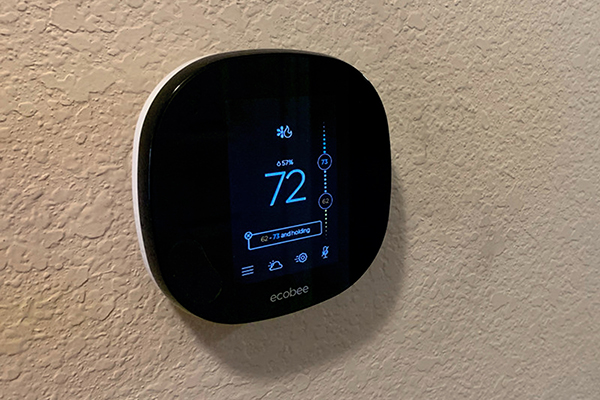Wi-Fi Becoming the Standard for Home Thermostats
The ubiquity of Wi-Fi technology has played a major role in bringing the cost of wireless-networked thermostats down dramatically.

 Wireless networking technology, or Wi-Fi, has changed many aspects of our daily lives — from personal computing to television viewing to backyard grilling — that it comes as no surprise Wi-Fi is impacting the heating and air conditioning industry as well.
Wireless networking technology, or Wi-Fi, has changed many aspects of our daily lives — from personal computing to television viewing to backyard grilling — that it comes as no surprise Wi-Fi is impacting the heating and air conditioning industry as well.
Like other Wi-Fi technology, a Wi-Fi thermostat connects to a home’s wireless network. Residents can then use an app on their smartphones and tablets to check and adjust the temperature in their homes. In other words, no more getting up from the couch to fiddle with the thermostat. They can also use the app to control and monitor the temperature when they’re not home.
“Using the app is basically like standing in front of the thermostat,” says Jim Klopfenstein of Oregon-based Day Heating & Cooling.
A decade ago, consumers could search out Wi-Fi thermostats for their homes, so long as they were willing to pay a hefty price for the new equipment. At that time, the difference between a unit enabled for Wi-Fi and a regular thermostat could be hundreds of dollars. “You had to be a diehard techie to want to go that route,” recalls Klopfenstein.
The New Standard
The ubiquity of Wi-Fi technology has played a major role in bringing the cost of wireless-networked thermostats down dramatically. Scan through the options at a local appliance or big box store and you find that a Wi-Fi-ready thermostat today costs only $10 or $15 more than one without it. In fact, Day Heating & Cooling doesn’t even offer non-Wi-Fi-ready units anymore. “At that price-point difference, it’s just easier to do it that way,” says Klopfenstein. “If customers don’t want to hook it up, they don’t
have to.”

As would be expected, thermostat manufacturers have refined Wi-Fi technology significantly. According to Klopfenstein, early models tended to monopolize networks’ bandwidth and could be interminably slow in how they transmitted information to connected devices. Those drawbacks don’t exist with newer models.
For snowbirds who travel to warmer climates for long periods during the year, a Wi-Fi thermostat can be especially useful for keeping track of their home furnaces…and finances. The same goes for people who own vacation homes. By checking for updates on their apps, they can detect breakdowns while they’re away and head off catastrophes like burst water pipes. They can also program the systems to provide them with notifications when the temperature of the house drops below a certain level.
Klopfenstein points out that manufacturers could even use the Wi-Fi technology to keep an eye on the servicing needs of furnace units from afar, although he says customers probably aren’t comfortable going that route yet. Nevertheless, Wi-Fi thermostats will only become more popular as more homeowners and landlords install smart home assistants like Amazon’s Alexa and Google’s Nest technology. “So many things require a Wi-Fi feature to tie them into smart home hubs now,” he notes, “that people are coming to expect Wi-Fi for their thermostats.”
Published: March 31, 2020
IN THIS ISSUE
Capitol Hill Update: Pension Reform Amid COVID-19 Legislative Frenzy
Contractor Completes COVID-19 Facility in Just 21 Days
Copper: A Shining Example for Germ Fighting
As scientists look for ways to battle the highly contagious coronavirus directly through vaccines, other researchers are studying copper as as a way to potentially prevent its spread in everyday settings.
Covid-19 Ripple Effects: Turning Crisis into Opportunity
What can we do as construction business owners, post-pandemic, to survive and thrive while the country climbs out of this mess?
Jason Watson Promoted to Executive Director, Labor Relations
Jason Watson has been promoted to executive director of labor relations at SMACNA National effective April 26. He previously served as director of labor relations at SMACNA for more than 15 years.
Mobilizing for the Future: Asset Management
As the world experiences increased uncertainty due to the COVID-19 pandemic, the importance of the construction industry in maintaining a robust civil infrastructure has been heightened.
Negative Air Creates Positive Environment for COVID Patients
As medical facilities deal with an unprecedented influx of patients in the wake of a global pandemic, SMACNA contractors that specialize in negative airflow HVAC system installation and maintenance are in high demand.
President's Column: Together, From A Distance
Showing Up as Your Best Self
Symptoms of a Slowdown?
The spread of a highly contagious virus has forced many industrial SMACNA contractors to adapt to a suddenly uncertain future.
The Balancing Act Takes Center Stage with COVID-19
SMACNA testing and air balancing (TAB) members across the country now find themselves serving as essential service providers for hospitals and healthcare facilities.
Wi-Fi Becoming the Standard for Home Thermostats
The ubiquity of Wi-Fi technology has played a major role in bringing the cost of wireless-networked thermostats down dramatically.


